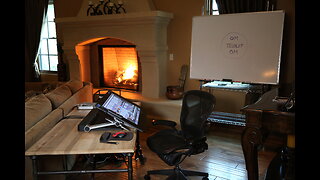George Frideric Handel Sonata for violin & continuo in F major Op 1 No 12 HWV 370
#GeorgeFridericHandel #Sonata #Violin #Continuo #FMajor #Opus1No12 #HWV370 #ClassicalMusic #MusicalComposition
Stefan Frenkel (violin)
Sterling Hunkins (’cello)
Ernst Victor Wolff (harpsichord)
George Frideric Handel's Sonata for Violin & Continuo in F Major Op. 1 No. 12 HWV 370 is a remarkable musical composition that showcases the composer's mastery of the Baroque style. Composed in the early 18th century, this sonata exemplifies Handel's ability to create captivating melodies, intricate harmonies, and virtuosic passages for the violin.
George Frideric Handel composed the Sonata for Violin & Continuo in F Major Op. 1 No. 12 HWV 370 during his time in Rome, Italy, around 1707-1709. Handel, a German-born composer, was renowned for his contributions to Baroque music and his ability to compose in a variety of genres. This sonata is part of a collection of twelve violin sonatas, known as "Sonates pour un traversière, un violon ou hautbois con basso continuo," which demonstrates Handel's mastery of the violin and his understanding of the harmonic possibilities of the continuo accompaniment.
Movement 1: Adagio
- The first movement of the sonata begins with a slow and expressive Adagio section.
- Handel establishes a poignant and lyrical melody, allowing the violin to sing over the continuo accompaniment.
- The movement showcases Handel's ability to create emotional depth and evoke a sense of introspection.
Movement 2: Allegro
- The second movement is an energetic Allegro, characterized by its lively and rhythmic nature.
- Handel presents a lively and spirited theme, which the violin explores through virtuosic runs, trills, and intricate passages.
- The movement displays Handel's skill in crafting engaging and thrilling music, designed to captivate the audience.
Movement 3: Largo
- The third movement offers a contrasting mood, with a slow and lyrical Largo section.
- Handel presents a tender and expressive melody, allowing the violin to showcase its expressive capabilities.
- The movement highlights Handel's ability to create emotional depth and elicit a sense of beauty and introspection.
Movement 4: Allegro
- The final movement is a lively Allegro, filled with energy and virtuosic passages.
- Handel's composition features rapid scales, arpeggios, and intricate ornamentation for the violin, demonstrating the technical prowess required for performance.
- The movement concludes the sonata with a spirited and exhilarating finale.
Handel's Sonata for Violin & Continuo in F Major Op. 1 No. 12 HWV 370 delivers a range of emotions and a display of virtuosity. From the introspective and expressive moments to the lively and spirited passages, the sonata evokes a sense of elegance, joy, and technical brilliance. Handel's skillful manipulation of dynamics, ornamentation, and melodic development allows for an engaging and emotionally rich performance, leaving the audience mesmerized.
Handel's Sonata for Violin & Continuo in F Major Op. 1 No. 12 HWV 370 remains an important work in the violin repertoire. Its beauty, technical demands, and expressive qualities have solidified its place as a staple in the Baroque era and beyond. The sonata's enduring popularity speaks to its timeless appeal and the lasting impact of Handel's compositional genius.
Conclusion:
George Frideric Handel's Sonata for Violin & Continuo in F Major Op. 1 No. 12 HWV 370 stands as a testament to the composer's exceptional talent and his mastery of the Baroque style. Through its captivating melodies, intricate harmonies, and virtuosic passages, the sonata takes listeners on a journey of elegance, beauty, and technical brilliance. Its continued presence in performances and recordings confirms its enduring significance in the realm of classical music, solidifying Handel's reputation as one of the greatest composers of the Baroque era.
You have the opportunity to support the channel:
https://destream.net/live/RadSiarAl/donate
https://www.buymeacoffee.com/6355radsiaral
-
![[D2] Onslaught Grind w/ Some PvP before Final Shape](https://hugh.cdn.rumble.cloud/s/fw/s8/1/5/g/l/6/5gl6r.0kob-small-D2-Onslaught-Grind-w-Some-P.jpg) LIVE
LIVE
CHiLi XDD
3 hours ago[D2] Onslaught Grind w/ Some PvP before Final Shape
406 watching -
 2:45
2:45
Chicks in the Office
2 hours agoHolly Madison Talks Reconciliation with Kendra Wilkinson
5.25K9 -
 LIVE
LIVE
Di bear
4 hours agoFinal Season Mission, Pantheon | Destiny 2
812 watching -
 LIVE
LIVE
SquallRush
6 hours agoAthenian Rhapsody!
566 watching -
 1:47:01
1:47:01
Real Coffee With Scott Adams
4 hours agoEpisode 2492 CWSA 06/01/24
17K32 -
 DVR
DVR
LFA TV
5 hours ago| WHISTLE BLOWERS 6.01.24 12pm EST
11.8K6 -
 1:13:59
1:13:59
Tactical Advisor
3 hours agoVault Room Tour/Unboxing- Vault Room Live Stream
13K2 -
 1:11:28
1:11:28
The Squad
9 hours agoArsenal's Huge Summer🚨Olise to Man Utd DEAL✅ Osimhen to Arsenal or Chelsea☑️ UCL Final Preview
23.9K6 -
 56:23
56:23
Trumpet Daily
23 hours ago $1.10 earnedCohen Is Free to Lie and Steal, but Trump Is Guilty of Something - Trumpet Daily | May 31, 2024
15.8K33 -
 8:26
8:26
MichaelBisping
21 hours agoBISPING CHOKES OUT STEVE-O! | JACKASS STAR PUT TO SLEEP BY UFC CHAMP! *FULL VIDEO*
37.8K12